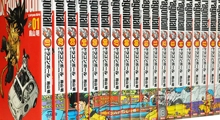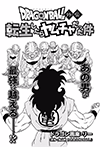With the serialization of Dr. Slump, Akira Toriyama’s longest-running manga series at the time, coming to an end in Weekly Shōnen Jump, the author was already considering what to draw for his next serialized series. Based on advice from his editor, Kazuhiko Torishima, Toriyama released a two-part manga one-shot entitled “Dragon Boy” in Fresh Jump in mid-1983 to test the viability of a kung-fu shōnen manga series. After an incredibly positive response from readers, Toriyama had finally decided on his next story, which would ultimately become his final, and undoubtedly his most famous, long-term serialized work — Dragon Ball.
The original Dragon Ball series debuted in November 1984, appearing weekly in the pages of Weekly Shōnen Jump for just over 10 years. Nearly 20 years to the date after the series’ original end in May 1995, Dragon Ball Super began its monthly serialization in the popular video game magazine V-Jump. Running as a companion to the Dragon Ball Super TV series, the manga series is written and drawn by Toyotarō with supervision and guidance from original series author Akira Toriyama.
The overall guide is divided up between the manga series’ chapters and their various publications, releases, and collected volumes. Detailed information covering the franchise’s numerous published guides and databooks can be found in the Databook Guide, while information concerning the various animated adaptations can be found in the Episode Guide.
Primary Manga Series
Both detailed and list views are available for each of the franchise’s main series: the original 1984-1995 Dragon Ball by Akira Toriyama, the 2013 prequel series Jaco the Galacatic Patrolman by Akira Toriyama, and the 2015-onward sequel series Dragon Ball Super by Toyotarō. The detailed view provides a quick synopsis of the series’ respective story arcs and the chapters that comprise them; a chapter-by-chapter break-down of each arc is also provided, along with detailed pages for each individual chapter, which includes title pages, chapter summaries, notes, author comments, and page breakdowns. The list view provides you with a quick glance at all of the chapters from that specific series, along with their publication dates.
11 Chapters, 1 Bonus Chapter (Dragon Ball Minus)
Pre-Production & Printing Information
The following three “mini-guides” address specific elements of the manga series and its various releases: the “Prototypes & Drafts” page discusses the series’ original roots in Journey to the West and its evolution over numerous drafts; the “Color Chapter Collection” page details all of the limited- and full-color chapters the Dragon Ball series received in its original Weekly Shōnen Jump serialization; and the “Spine Art Collection” page showcases all of the special collages and montages created by lining up various editions of the manga.
Publications & Releases
Outside of its original serialization in Weekly Shōnen Jump, the Dragon Ball manga has been made available in Japan to consumers in various formats and quality. These options include the tankōbon, which were released as the series was being published in Weekly Shōnen Jump, the kanzenban, a “perfect edition” which started to be released in late 2002, the colorized versions available in both print and digital editions, and the most recent “Digest Editions” that attempt to reproduce the manga’s original serialization. For more information on these various release formats, visit their respective pages listed below. It is also recommended you take a look at the “Manga Comparison” feature, which provides a detailed comparison of the original weekly serialization, the economic tankōbon, and the more expensive kanzenban.
Over the years, other manga releases have been published to capitalize on Dragon Ball’s success. These releases include the various animation comics, which contain screen shots of the animation adaptations of the manga presented in a comic form and official spin-off series. More information on these releases can be found by visiting their respective pages in this guide.
Original & Current Serialization
“Serialization” refers to the original, first-run printing of a series, generally on a chapter-by-chapter basis. For the original Dragon Ball manga — published weekly over the course of 1984 to 1995 — this was as a part of Shueisha’s Weekly Shōnen Jump anthology magazine. For subsequent spin-offs and sequel series, serialization came in the form of everything from quarterly, to bimonthly, to monthly publications across a range of magazines.
Release Information
Released:20 November 1984 – 23 May 1995
Retail:¥170 – ¥210
Book Size:JIS B5 (18.2 × 25.7 cm)
Publisher:Shueisha
Volumes:516 issues
Release Information
Released:Ongoing
Retail:Various
Book Size:Various
Publisher:Shueisha
Dragon Ball Collected Releases
To date the Dragon Ball manga has been collected and released in five separate compilation formats, outside of its weekly serialization in Weekly Shōnen Jump, all with varying sizes, print quality, and color palettes.
Release Information
Released:10 September 1985 – 04 August 1995
Retail:¥400
Book Size:New Book Format (11 × 17 cm)
Publisher:Shueisha
Volumes:42 volumes
Release Information
Released:04 December 2002 – 02 April 2004
Retail:¥933
Book Size:JIS A5 (14.5 × 21 cm)
Publisher:Shueisha
Volumes:34 volumes
Release Information
Released:04 February 2013 – 04 July 2014
Retail:¥630
Book Size:New Book Format (11 × 17 cm)
Publisher:Shueisha
Volumes:20 volumes
Release Information
Released:13 May 2016 – 13 January 2017
Retail:¥500 – ¥650
Book Size:JIS B5 (18.2 × 25.7 cm)
Publisher:Shueisha
Volumes:18 volumes
Release Information
Released:04 February 2013 – 04 October 2013
Retail:¥473
Book Size:Digital Format
Publisher:Shueisha
Volumes:42 volumes
Dragon Ball Super Collected Releases
The Dragon Ball Super manga has only been collected and released outside of its monthly serialization in V-Jump in a black and white tankōbon format.
Release Information
Released:20 June 2015 – present
Retail:¥550 – ¥580
Book Size:JIS B5 (18.2 × 25.7 cm)
Publisher:Shueisha
Volumes:95+ issues
Release Information
Released:04 April 2016 – present
Retail:¥400 – ¥440
Book Size:New Book Format (11 × 17 cm)
Publisher:Shueisha
Volumes:20+ volumes
Animation Comics
These releases contain stills, or screen shots, from animated material and arranged as comic-book panels, with added sound-effects and dialogue bubbles.
Release Information
Released:25 March 1992 – 04 October 2013
Retail:¥690 – ¥733
Book Size:New Book Format (11 × 17 cm)
Publisher:Shueisha
Volumes:22 volumes
Release Information
Released:04 November 2005 – 04 December 2019
Retail:¥710 – ¥1,000
Book Size:New Book Format (11 × 17 cm)
Publisher:Shueisha
Volumes:42 volumes
Release Information
Released:12 July 2004 – 12 April 2010
Retail:¥650 (Film) / ¥550 (TV)
Book Size:JIS B6 (12.8 × 18.2 cm)
Publisher:Shueisha
Volumes:21 volumes
Others/Miscellaneous Releases
In addition to the releases categorized above, other various official releases have been published, including spin-off material from the anime staff, new authors Naho Ooishi and Toyotarō, and even Akira Toriyama.
Release Information
Released:1989 – present
Retail:Various
Book Size:Various
Publisher:Shueisha
Volumes:Multiple series, many on-going



Release Information
Released:25 August 1994 – December 1995
Retail:¥450 (TV) / ¥480 (Film)
Book Size: (10.5 × 14.5 cm)
Publisher:Shueisha
Volumes:17 volumes












































